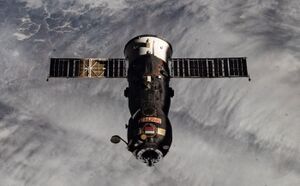Engineering:Progress MS-15
 Progress MS-15 after undocking from the ISS | |
| Names | Progress 76P |
|---|---|
| Mission type | ISS resupply |
| Operator | Roscosmos |
| COSPAR ID | 2020-050A |
| SATCAT no. | 45937 |
| Website | https://www.roscosmos.ru/ |
| Mission duration | 1718 days, 9 hours, 39 minutes |
| Spacecraft properties | |
| Spacecraft | Progress MS-15 |
| Spacecraft type | Progress MS |
| Manufacturer | Energia |
| Launch mass | 7000 kg |
| Payload mass | 2540 kg |
| Start of mission | |
| Launch date | 23 July 2020, 14:26:21 UTC[1][2][3] |
| Rocket | Soyuz-2.1a |
| Launch site | Baikonur, Site 31 |
| Contractor | Progress Rocket Space Centre |
| End of mission | |
| Disposal | Deorbited |
| Decay date | 9 February 2021, 09:13 UTC [4] |
| Orbital parameters | |
| Reference system | Geocentric orbit |
| Regime | Low Earth orbit |
| Inclination | 51.65° |
| Docking with ISS | |
| Docking port | Pirs nadir |
| Docking date | 23 July 2020, 17:45 UTC |
| Undocking date | 9 February 2021, 05:21 UTC |
| Time docked | 200 days, 11 hours, 36 minutes |
| Cargo | |
| Mass | 2540 kg |
| Pressurised | 2540 kg |
| Fuel | 620 kg |
| Gaseous | 46 kg (oxygen) |
| Water | 420 kg |
Progress ISS Resupply | |
Progress MS-15 (Russian: Прогресс МC-15), Russian production No. 444, identified by NASA as Progress 76P, was a Progress spaceflight operated by Roscosmos to resupply the International Space Station (ISS). This was the 167th flight of a Progress spacecraft.[5]
History
The Progress-MS is an uncrewed freighter based on the Progress-M featuring improved avionics. This improved variant first launched on 21 December 2015. It has the following improvements:[5][6][7]
- New external compartment that enables it to deploy satellites. Each compartment can hold up to four launch containers. First time installed on Progress MS-03.
- Enhanced redundancy thanks to the addition of a backup system of electrical motors for the docking and sealing mechanism.
- Improved Micrometeoroid (MMOD) protection with additional panels in the cargo compartment.
- Luch Russian relay satellites link capabilities enable telemetry and control even when not in direct view of ground radio stations.
- GNSS autonomous navigation enables real time determination of the status vector and orbital parameters dispensing with the need of ground station orbit determination.
- Real time relative navigation thanks to direct radio data exchange capabilities with the space station.
- New digital radio that enables enhanced TV camera view for the docking operations.
- The Ukraine Chezara Kvant-V on board radio system and antenna/feeder system has been replaced with a Unified Command Telemetry System (UCTS).
- Replacement of the Kurs A with Kurs NA digital system.
Launch
A Soyuz-2.1a launch vehicle was used to launch Progress MS-15 to the International Space Station. Progress MS-15 was launched at 14:26:21 UTC from Baikonur Cosmodrome Site 31 on a fast-track trajectory. Following a nominal launch, Progress MS-15 docked with the Pirs port on the ISS two orbits later at 17:45:00 UTC.[3][8]
Docking
Around 3 hours 20 minutes after the launch, Progress MS-15 successfully docked automatically at the nadir port of the Pirs module at 17:45:00 UTC,[3][8][9] where it remained until February 2021.[4] After its mission was completed, Progress MS-15 departed and re-entered the Earth's atmosphere for destruction over the South Pacific Ocean.[4]
Cargo
The Progress MS-15 spacecraft delivered 2,540 kg (5,600 lb) of cargo, with 1,430 kg (3,150 lb) of this being dry cargo. The following is a breakdown of cargo bound for the ISS:[1]
- Dry cargo: 1,430 kg (3,150 lb)
- Fuel: 620 kg (1,370 lb)
- Oxygen: 46 kg (101 lb)
- Water: 420 kg (930 lb)
Undocking and decay
The Progress MS-15 remained docked at the station through on 9 February 2021, when it departed with trash and re-entered the Earth's atmosphere for destruction over the South Pacific Ocean.[4] The Pirs module, originally scheduled to be removed and discarded at the end of this mission,[10][11] will stay attached to the station until the arrival of the Nauka module.
See also
References
- ↑ 1.0 1.1 "Progress MS-15 cargo spacecraft launched from the Baikonur Cosmodrome". Roscosmos. 23 July 2020. http://en.roscosmos.ru/21586/.
- ↑ "Launch Schedule". Spaceflight Now. 23 July 2020. https://spaceflightnow.com/launch-schedule/.
- ↑ 3.0 3.1 3.2 Navin, Joseph; Gebhardt, Chris (23 July 2020). "Progress MS-15 arrives at Station with eventful automated docking". NASASpaceFlight.com. https://www.nasaspaceflight.com/2020/07/roscosmos-progress-ms-15/.
- ↑ 4.0 4.1 4.2 4.3 "Прогресс МС-15 завершил свой полет" (in ru). Roscosmos. 9 February 2021. https://www.roscosmos.ru/29938/.
- ↑ 5.0 5.1 Krebs, Gunter (1 December 2015). "Progress-MS 01-19". Gunter's Space Page. https://space.skyrocket.de/doc_sdat/progress-ms.htm.
- ↑ "Progress MS-15 2020-050A". NASA. 10 February 2021. https://nssdc.gsfc.nasa.gov/nmc/spacecraft/display.action?id=2020-050A.
 This article incorporates text from this source, which is in the public domain.
This article incorporates text from this source, which is in the public domain.
- ↑ Zak, Anatoly. "Progress-MS". RussianSpaceWeb.com. http://www.russianspaceweb.com/progress-ms.html.
- ↑ 8.0 8.1 Clark, Stephen (23 July 2020). "Progress supply ship docks with space station after last-minute misalignment". Spaceflight Now. https://spaceflightnow.com/2020/07/23/soyuz-progress-ms-15/.
- ↑ Zak, Anatoly (23 July 2020). "Progress MS-15 arrives at ISS". RussianSpaceWeb.com. http://russianspaceweb.com/progress-ms-15.html.
- ↑ Zak, Anatoly (22 March 2017). "Integrating the MLM Nauka with ISS". RussianSpaceWeb.com. http://www.russianspaceweb.com/iss-fgb2-mlm-integration.html.
- ↑ Atkinson, Ian (19 August 2020). "Russia's Nauka Arrives Baikonur for final launch preparations". NASASpaceFlight.com. https://www.nasaspaceflight.com/2020/08/nauka-arrives-baikonur-final-preps/.
 |


